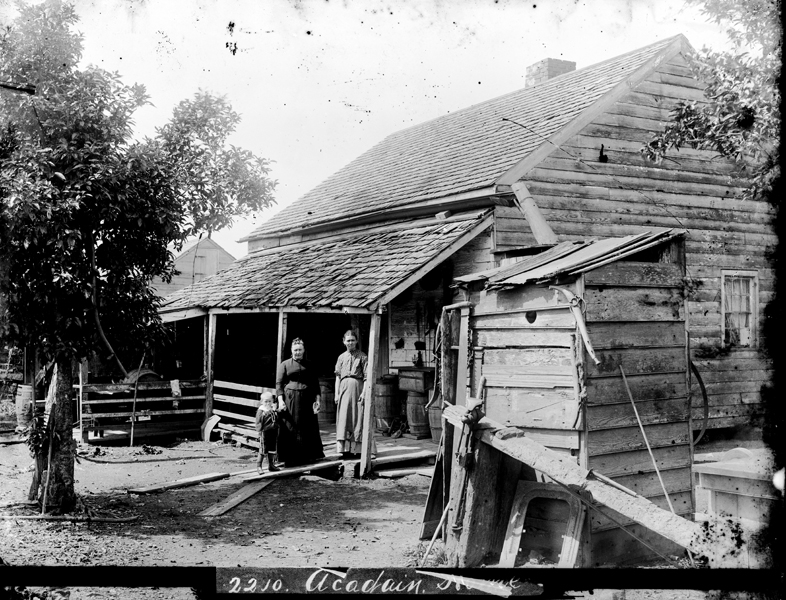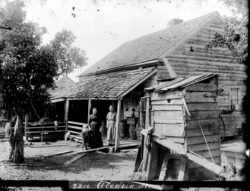George Francois Mugnier
The images shot by New Orleans photographer George Mugnier illustrate the life and times of Louisiana as the state entered the twentieth century.

Courtesy of Louisiana State Museum
Acadian Home. Mugnier, George François, 1855-1936
The images shot by New Orleans photographer George François Mugnier illustrate the life and times of Louisiana as the state entered the twentieth century. Mugnier was not a historian, social commentator, or creative artist, though his work encompasses all of these dimensions. He was a photographer, and essentially a technician, who enjoyed capturing his surroundings on glass negatives and in print. His work can be viewed as both aesthetic and historical documents of a period of Louisiana’s history marked by social, political, and economic change as seen in his images of patrician mansions, farm workers’ cabins, field hands cutting sugarcane on plantations in South Louisiana, cotton pickers in North Louisiana fields, roustabouts moving cargo on the docks of Mississippi River wharves, and steam packets cramped along the levees of New Orleans.
Mugnier was born on January 1, 1857, in either Switzerland or France. His father, Jules Jacques Mugnier, a watchmaker by trade, moved to New Orleans with his young son shortly after the Civil War. The young Mugnier followed his father in the watchmaking craft and was supporting himself by the time he was eighteen. Little is known of Mugnier’s early years in New Orleans, but subsequent events indicate that he became interested in the relatively new field of photography. In 1884 he opened a commercial photography studio at 24 Exchange Alley in New Orleans, where for four years he produced stereoscopic prints, panoramas, portraits, and rural and urban photographs to sell to tourists or to anyone who took an interest.
The studio closed in 1888, apparently because the business had proven economically unsuccessful. For several years Mugnier continued to pursue his interest in photography from his home at 12 and 14 Exchange Alley, but he finally took employment as an assayer’s clerk at the New Orleans branch of the United States Mint. In 1894 Mugnier was again able to make a living in photography. He joined the Photo-Electric Engraving Company of New Orleans, where he was welcomed as an expert photographer. Between 1894 and 1923 his restlessness led him to a variety of jobs, including foreman in the photoengraving department of the New Orleans Times-Democrat, automobile mechanic, and machinist. During these years Mugnier continued, in his spare time and between jobs, to transmit images of life in Louisiana to glass and paper.
The techniques Mugnier used in his work were products of nineteenth-century photographic experiments by such scientists and painters as Joseph Nicéphore Niépce and Louis Jacques Mandé Daguerre, who developed the daguerreotype in the late 1830s. In 1851 a new phase of photography began with the announcement of the collodion, or wet-plate, process by the English sculptor and photographer Frederick Scott Archer. The collodion method enjoyed great popularity in the United States and was used by Mugnier in his earlier work. In later years, Mugnier used the dry-plate or gelatin-silver bromide introduced by Dr. Richard Leach Maddox in the 1870s.
Lower costs and the simplicity of the dry-plate process offered photographers greater mobility in pursuing their subjects. Hundreds of photographers scoured the cities and countryside of America, photographing anything that interested them. In New Orleans the number of professional photographers increased from eighteen in 1870 to twenty-seven in 1890, and the number of photographic supply houses tripled by 1900. To meet the needs of their increasing numbers, professionals and amateurs joined together in the late 1880s to form the New Orleans Camera Club.
Today, social and architectural historians can use Mugnier’s images as primary materials for the study of his period. The images also can be viewed as the aesthetic work of an accomplished photographer. When Mugnier sold his collection of photographic prints and glass negatives to the Louisiana State Museum in New Orleans in 1930, he probably realized he had given future generations an important visual legacy. Mugnier died on April 12, 1938, and is buried in Metairie Cemetery in New Orleans.
Mugnier photographs can be found in the collections of the Louisiana State Museum, the Historic New Orleans Collection, the New Orleans Public Library, and Louisiana State University Libraries Special Collections in Baton Rouge.
